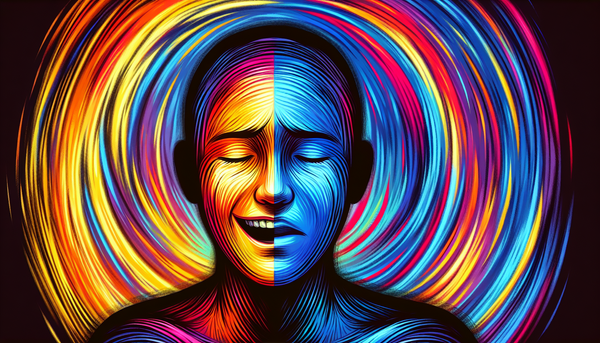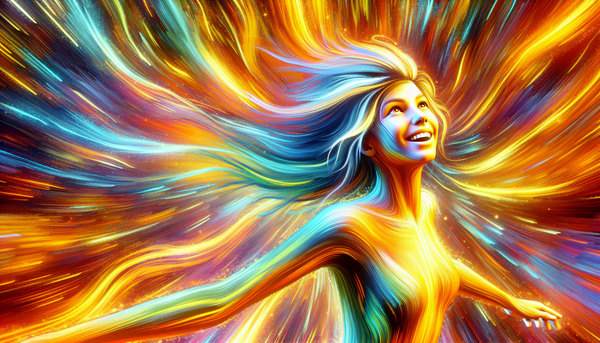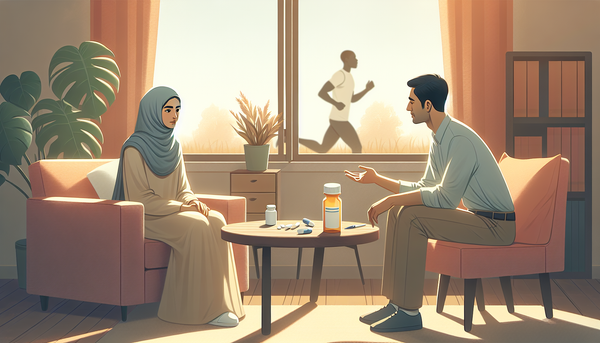
Understanding Bipolar Disorder: Symptoms, Management, and Support
Bipolar disorder triggers profound mood swings that can shape every corner of one’s life. Recognizing these signs is pivotal—for you or someone close. This article demystifies bipolar disorder, detailing its symptoms, management, and the support that can bring stability to the chaos, paving the way to a better quality of life.
Key Takeaways
-
Bipolar disorder is characterized by extreme mood episodes such as manic, hypomanic, or depressive states, which are intense, persist for extended periods, and significantly disrupt daily life.
-
The disorder encompasses distinct classifications including bipolar I, bipolar II, and cyclothymic disorder, each with unique symptoms and severity, underlining the necessity of tailored treatment strategies.
-
Effective management of bipolar disorder combines medication, therapy, and lifestyle changes to control symptoms, prevent relapses, and requires attention to potential co-occurring conditions and complications.
Recognizing Bipolar Disorder

Bipolar disorder, a complex mental health condition, is characterized by significant fluctuations in mood, energy levels, behavior, and thinking patterns. While these bipolar disorder symptoms may seem abstract, they manifest in concrete ways, impacting an individual’s daily life and relationships. A key hallmark of bipolar disorder is the presence of episodes marked by extreme moods, known as manic or depressive episodes.
Grasping these episodes is vital for identifying bipolar disorder. These episodes are not mere mood swings but are intense, prolonged periods of distressing emotions that can disrupt an individual’s life. The severity and duration of these episodes distinguish bipolar disorder from normal mood changes.
Mood Swings and Episodes
Mood episodes in bipolar disorder are intense periods of emotional highs and lows that persist for weeks or even longer. These episodes are typically characterized by mania or hypomania and depression, leading to erratic changes in mood and behavior.
Common triggers for these episodes include:
-
Stress
-
Hormonal changes
-
Lack of sleep
-
Substance use
These triggers can cause drastic mood swings, leading to severe disruptions in daily life. Hence, identifying these triggers and comprehending the character of these episodes is key to managing bipolar disorder.
Manic Episodes

Manic episodes in bipolar disorder are characterized by manic symptoms such as:
-
Abnormally elevated energy levels
-
Restlessness
-
Reduced need for sleep
-
Heightened activity
-
Agitation
-
Inflated sense of well-being
These episodes can last from a few days to several months, often averaging around 13 weeks.
Common triggers for manic episodes include stress, sleep deprivation, and adverse life events. These triggers can also lead to hypomanic and depressive symptoms in bipolar disorder, also known as manic depression. Recognizing these triggers and the character of manic episodes is vital for the management and treatment of bipolar disorder.
Depressive Episodes

Depressive episodes in bipolar disorder are marked by:
-
Persistent low mood
-
Loss of interest in activities
-
Feelings of worthlessness
-
Extending for at least two weeks and sometimes longer
These episodes are not just periods of feeling down or upset; they represent a significant change in mood and behavior, drastically affecting daily functioning and potentially leading to psychotic symptoms.
Various factors, such as:
-
certain medications
-
seasonal changes
-
stress
-
poor sleep
-
hormonal changes
can lead to a depressive episode in individuals with bipolar disorder. Identifying these triggers and comprehending the nature of depressive episodes is important for managing bipolar disorder.
Types of Bipolar Disorder: An Overview
Bipolar disorder is not a one-size-fits-all diagnosis. It encompasses various classifications, including bipolar I, bipolar II, and cyclothymic disorder, each with its unique characteristics and severity of episodes.
There are several types of bipolar disorder, each with its own unique characteristics. These include:
-
Bipolar I disorder: This is characterized by severe manic episodes, which can last for at least a week. These episodes may be accompanied by depressive episodes as well, sometimes referred to as manic depressive illness.
-
Bipolar II disorder: This involves hypomanic episodes, which are less severe than full-blown manic episodes. Individuals with bipolar II disorder also experience depressive episodes.
-
Cyclothymic disorder: This is a milder form of bipolar disorder, characterized by numerous episodes of hypomania and depressive symptoms. These symptoms must last for at least two years to be diagnosed as cyclothymic disorder.
Understanding these different types of bipolar disorder can help in accurate diagnosis and the development of tailored treatment strategies.
Unraveling the Causes of Bipolar Disorder
The specific reason for bipolar disorder is still not clearly understood. Its exact cause has not been identified. However, several contributing factors have been identified, including genetics, brain structure, and environmental influences.
Factors that can increase the likelihood of developing bipolar disorder include:
-
A family history of bipolar disorder
-
Structural brain abnormalities, especially in the prefrontal cortex
-
Environmental factors such as childhood experiences, stressful life events, substance abuse, and sleep disturbances
Comprehending these factors can yield valuable insights into the intricate etiology of bipolar disorder.
Diagnosing Bipolar Disorder: Steps and Challenges
Diagnosis is a critical step in managing bipolar disorder. However, the process is not straightforward and presents several challenges. The overlap of symptoms with other psychiatric disorders and the requirement for expertise in identifying bipolar disorder makes the diagnosis a complex task.
The diagnosis of bipolar disorder entails:
-
A comprehensive mental health evaluation of symptoms
-
A physical examination
-
Diagnostic interviews
-
Assessment tools such as the Bech-Rafaelsen Mania Rating Scale, the Quick Inventory of Depressive Symptomatology, and the Bipolar Inventory of Symptoms Scale
Despite these tools, diagnosing bipolar disorder can still be challenging due to its overlapping symptoms with other mental health conditions and the potential for misdiagnosis.
Treatment Approaches for Bipolar Disorder

Successful management of bipolar disorder involves a combination of medications, therapy, and lifestyle changes. The goal of treatment is to control the symptoms, prevent relapse, and improve the quality of life of individuals living with bipolar disorder.
Medications
Medications play a pivotal part in the management of bipolar disorder. Mood stabilizers, for example, function by reducing abnormal activity in the brain, thereby mitigating mood swings and preventing manic and depressive episodes. Antipsychotic medications, on the other hand, address acute phases, prevent relapses, and alleviate symptoms such as mania and psychosis.
However, the use of medications requires careful consideration. For instance, antidepressants should be used cautiously due to their potential to trigger mania or rapid cycling. The evidence supporting their efficacy in treating bipolar depression is limited.
Therapy
Psychotherapy, or ‘talk’ therapy, plays a crucial part in treating bipolar disorder. It assists individuals in understanding and managing their symptoms, improving coping skills, and enhancing relationships.
Several types of therapy can be beneficial for individuals with bipolar disorder. Cognitive behavioral therapy (CBT), for example, can help individuals modify challenging or distorted thinking patterns, thereby decreasing harmful impulses and behaviors.
Family-focused therapy, on the other hand, can engage children in the therapeutic process and enable them to comprehend their responsibility in supporting their loved one’s treatment.
Lifestyle Changes
Alongside medication and therapy, lifestyle adjustments play a vital role in managing bipolar disorder. Regular exercise, for instance, can channel excess energy and alleviate depressive symptoms. A balanced diet, particularly with an increased intake of omega-3 fatty acids, can aid in stabilizing mood and energy levels.
Maintaining a regular sleep schedule is also essential due to the link between sleep disturbances and depleted energy levels. Manic episodes often involve a reduced need for sleep, highlighting the significance of consistent sleep patterns in managing bipolar disorder.
Coping Strategies and Support for People with Bipolar Disorder
Living with bipolar disorder entails more than just medical intervention. Developing coping skills and seeking support are equally vital in managing the condition. Essential strategies involve establishing healthy daily routines, incorporating mindfulness practices, and staying connected to supportive individuals. Such coping strategies can help individuals effectively manage their symptoms and navigate life with bipolar disorder.
Support groups for bipolar disorder play a vital role in providing emotional backing and pragmatic guidance for managing the condition. These groups create a community of individuals who comprehend the difficulties of living with bipolar disorder, exchanging experiences, coping mechanisms, and providing encouragement.
Navigating Bipolar Disorder in Children and Adolescents
Comprehending and managing bipolar disorder in children and adolescents can be especially daunting. The overlap of symptoms with other psychiatric disorders and the potential misdiagnosis as ADHD or schizophrenia can make the diagnosis a complex task.
Despite these challenges, bipolar disorder in young individuals can be managed effectively. Mood stabilizers, antipsychotic drugs, and psychotherapy are available treatment options for pediatric and adolescent patients diagnosed with bipolar disorder.
Co-occurring Conditions and Complications
Leaving bipolar disorder untreated can lead to severe complications including:
-
Insomnia
-
Rapid speech
-
Feelings of euphoria
-
Increased risks of suicide attempts
-
Issues related to drug and alcohol use
-
Legal or financial problems
-
Impaired relationships
Furthermore, individuals diagnosed with bipolar disorder often experience concurrent mental disorders, such as anxiety and substance abuse. The presence of these co-occurring conditions can significantly hinder the treatment of bipolar disorder, thereby complicating the management of the disorder and diminishing the prognosis.
Summary
Bipolar disorder, a complex mental health condition, presents numerous challenges in diagnosis, treatment, and management. Despite these challenges, understanding the disorder, its types, causes, symptoms, and potential complications can equip individuals and their loved ones with the knowledge and tools to manage the condition effectively. With proper treatment, healthy lifestyle changes, supportive social networks, and effective coping strategies, individuals with bipolar disorder can lead fulfilling lives.
Frequently Asked Questions
How does a bipolar person feel?
A bipolar person may experience episodes of severe depression and episodes of mania, which can include overwhelming joy, excitement, increased energy, and reduced need for sleep. Each person's experience with bipolar disorder is unique and can vary widely.
What is typical bipolar behavior?
Typical bipolar behavior can include episodes of depression and highs, during which the individual may feel 'hyper' or 'wired', experience racing thoughts, and engage in reckless behavior. It can also cause mood swings from extreme highs to extreme lows, with symptoms such as increased energy, excitement, impulsive behavior, and agitation.
How does bipolar affect you emotionally?
Bipolar disorder can cause extreme shifts in mood, from elation and agitation during manic episodes to extreme low energy and depressive thoughts during depressive episodes. These mood swings can be overwhelming and confusing, leading to significant behavioral changes.
What is the first red flag of bipolar disorder?
The first red flag of bipolar disorder is needing less sleep, which can be an early indicator of an oncoming manic episode. Monitoring your sleep patterns can provide valuable insight into your mood states.
What are the different types of bipolar disorder?
Bipolar disorder includes bipolar I, bipolar II, and cyclothymic disorder, each with distinct characteristics and severity of episodes. Understanding these types is crucial for proper diagnosis and treatment.


